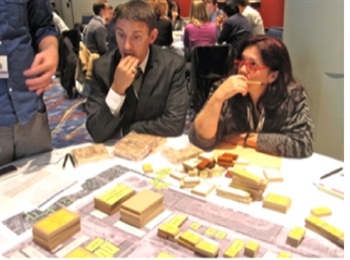
By Carl Knutson, Perkins & Will
Rendering of Whistler Crossing, Riverdale, Ill.
MPC Research Assistant Morgan Davis wrote this blog post.
When you think of a green neighborhood, what do you envision? Parks, trees and open space? Lots of destinations within a short walk or bike ride? New types of public transportation, such as streetcars? These are the questions the Metropolitan Planning Council (MPC) posed to participants at Greenbuild 2010, a conference and expo dedicated to green building.

Greenbuild attendees use building blocks to create a green neighborhood.
In partnership with the U.S. Green Building Council (USGBC) Fregonese Associates, and Farr and Associates, MPC adapted its Corridor Development Initiative tool for a session designed to bring to life USGBC's LEED for Neighborhood Development (LEED-ND) certification program. After learning the key elements of LEED-ND, participants used building blocks to create green neighborhoods on an aerial map of a real site in Riverdale, Ill., a south suburb of Chicago. Everyone was encouraged to incorporate a variety of green approaches, including historic preservation, mixed-use and mixed-income development, and open space, to create design concepts that fulfilled LEED-ND criteria.
Once participants' designs were constructed, facilitators used a pro forma to calculate whether the developments generated enough revenue to be feasible, and architects sketched the concepts that worked. To conclude the building block exercise, Doug Farr of Farr Associates — architect and site planner for Whistler Crossing the actual site, which is now an award-winning community — revealed what elements were included to make Whistler Crossing LEED-ND certified.
An important LEED-ND criteria is effective community engagement. While this exercise was conducted in a conference setting, it demonstrated how using tools such as the Corridor Development Initiative can help make sustainable and green neighborhood development techniques more accessible and real for local residents.